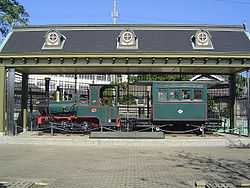Botchan Ressha

The original railway

The train was small even by narrow-gauge standards as passengers, almost invariably noted. Osman Edwards, who visited Matsuyama in 1898, wrote "Dōgō is only a short distance from the seashore, and is reached in half-an-hour by what I can only describe as a toy train."[3] A character in Eliza Scidmore's 1907 novel, As the Hague Ordains comments: "Such a railway! The tiniest miniscule[sic] of a railway — a string of netsukes is the train. I might hang the locomotive on my watch chain — a breloque merely. So droll."[4]
Most famously, the train was depicted in Natsume Soseki's 1906 novel, Botchan: "I found the train station soon enough and bought myself a ticket. When I got on the train, it looked as dinky as a matchbox. It had hardly started to get rolling when it was already time to get off; the whole ride couldn't have taken more than five minutes. No wonder the ticket was so cheap, I thought — only three sen!" [5]
Demise and rebirth

On October 12, 2001, a diesel-powered replica was introduced by Iyotetsu. Currently, the Botchan Ressha runs on two of the Iyotetsu city lines: ten round trips daily on the Jonan line (from Dogo to Matsuyama City Station) and four round trips daily on the Hanazono line between JR Matsuyama Station and Dogo, stopping at Komachi.
References
- ↑ Yuichiro Kishi, "Railway Operators in Japan 13: Shikoku Region," Japan Railway & Transport Review 39 (2004): 44.
- ↑ Basil Hall Chamberlain and W. B. Mason, A Handbook for Travellers in Japan (4th edition, London: Murray, 1894).
- ↑ Osman Edwards, Japanese Plays and Playfellows (London: Heinemann, 1901), 200.
- ↑ Eliza Scidmore, As the Hague Ordains (New York: H. Holt, 1908), 37.
- ↑ Natsume Soseki, Botchan: A Modern Classic, tr. Joel Cohn (Kodansha, 2007), 27.ISBN 4770030487
- ↑ Dallas Finn, Meiji revisited: the sites of Victorian Japan (New York: Weatherhill, 1995), 141.